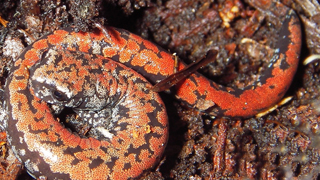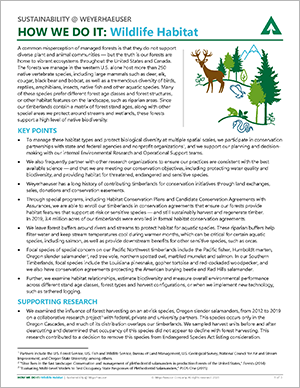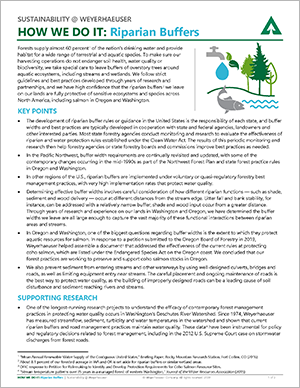 FORESTS IN THE WESTERN U.S.
FORESTS IN THE WESTERN U.S.
2.5 million acres
Weyerhaeuser’s first timberlands were in the Pacific Northwest, dating back to when we purchased 900,000 acres of forestlands in Washington state in 1900. Today, we own approximately 2.5 million acres of highly productive forests in Oregon and Washington. The region's wet and mild climate, with most of the annual precipitation falling during the winter months, makes for incredible growing conditions. Our timberlands span from southern Oregon to the North Cascade Mountains in Washington, and they range in elevation from a few hundred feet to as high as 5,550 feet.
The geology of the region tells a compelling story. Chains of volcanic islands collided with the North American continent to become portions of western Oregon and Washington. The volcanic peaks that make up the Cascade Mountains testify to a long history of eruptions that continue today, including the 1980 eruption of Mount St. Helens. The rugged terrain is the result of the continued uplift of mountains, and, as the mountains rise, they are subject to the erosive forces of weather, and those of streams and rivers that carry sediment and nutrients to the ocean. This interaction of geology, topography, soils, biology and climate makes the region among the most productive conifer-growing areas in the world.
FOREST MANAGEMENT
Our timberlands in the western United States were historically dominated by Douglas-fir, the primary species we still plant and harvest today. We also grow and harvest several other native species, including noble fir, grand fir, western red cedar, Sitka spruce, Engelmann spruce, ponderosa pine, western larch, lodgepole pine and red alder. Our timberlands in the western U.S. are proof of the core tenet of sustainable forestry, as we are now planting our third generation of trees in many locations — including more than 400,000 acres of the original land our founder purchased back in 1900. In Washington and Oregon, we reforest all our harvested sites by directly planting superior and climate-adapted tree seedlings. With few exceptions, these harvest sites are replanted within two years.
Our intensive forest management includes planting seedlings produced through our world-class selection, breeding and field-testing program; fertilizing the soil only where needed; preventing competing vegetation from overcrowding young trees in their first few growing seasons; and thinning stands during their growing cycle to support robust growth.
ENVIRONMENTAL STEWARDSHIP
We recognize our practices affect flora and fauna that are dependent on our sustainably managed forests. Through special programs administered under the federal Endangered Species Act, including Habitat Conservation Plans, Safe Harbor Agreements and Candidate Conservation Agreements with Assurances, we are able to enroll our timberlands in conservation agreements that ensure our forests provide habitat features that support at-risk or sensitive species — and still sustainably harvest and regenerate timber. In fact, we have almost 2 million acres enrolled in formal conservation agreements in our Western Timberlands region.
Since our timberlands contain a matrix of forest stand ages, along with other special areas we protect around streams and wetlands, these forests support a high level of native biodiversity. The forests we manage in the western U.S. host more than 250 native vertebrate species, including large mammals such as deer, elk, cougar, black bear and bobcat, as well as a tremendous diversity of birds, reptiles, amphibians, insects, native fish and other aquatic species. Birds of prey, such as goshawks, red-tailed hawks, bald and golden eagles, and ospreys, call our forests home, and numerous species of neotropical migratory birds return to our Pacific Northwest forests each spring to nest. Salamanders and other amphibians inhabit the uplands and riparian areas on our timberlands, and streams in our forests provide productive habitat for native fish species, such as salmon and trout, and aquatic amphibians. Focal species of special concern on our Pacific Northwest timberlands include the Pacific fisher, coastal marten, Oregon slender salamander, red tree vole, northern spotted owl, marbled murrelet and salmon.
We leave forested buffers around rivers and streams to protect habitat for aquatic species. These riparian buffers help filter water and keep stream temperatures cool during warmer months, which can be critical for certain aquatic species, including salmon, as well as provide downstream benefits for other sensitive species, such as orcas.
Different species groups are dependent on different forest age classes and associated forest structures, and the matrix of forest stand ages across our lands means our workings forests provide much of the habitat diversity they require. Adjacent to — and intermingled with — some of our ownership is public forestland, which often includes stands with much older age classes. At the landscape scale, this diversity of ownership, age class and forest structure provides a wide range of habitat for native species.
RESEARCH AND PARTNERSHIPS
To sustainably manage our forests, it is important that we continue to learn about how our activities affect both the forest ecosystem and surrounding communities. We frequently partner with other organizations to ensure our practices are consistent with the best available science and meet our conservation objectives. These research partnerships provide important insights and help us assess the effectiveness of our current management practices for protecting water quality and providing habitat for threatened, endangered and sensitive species. Partners include state and federal agencies, universities and nongovernmental research organizations, including the U.S. Forest Service, U.S. Fish and Wildlife Service, U.S. Geological Survey, National Council for Air and Stream Improvement, Inc., Oregon State University and many others.
Three key recent projects involve the influence of forest harvesting on at-risk species, the role of young forests as long-term habitat for red tree voles, and measuring the impacts of vegetation control through an intensive forest management study.
Ensuring the protection of the Oregon slender salamander
We examined the influence of forest harvesting on an at-risk species, the Oregon slender salamander, from 2012 to 2019 on a collaborative research project with federal, private and university partners. This species occurs only in the northern portion of the Oregon Cascades, and much of its distribution overlaps our timberlands. We sampled units before and after harvest and found that occupancy of this species did not decline due to harvest activities. This research is a great example of how working forests and at-risk species coexist.
Learn more about our multi-year study of Oregon slender salamanders
Research shows red tree voles find a home in young, managed forests
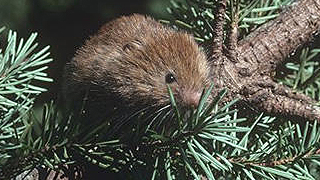
Red tree voles are small rodents that spend most of their lives in the canopy of Douglas-fir trees and were until recently considered for listing under the Endangered Species Act. Although most monitoring efforts have found that red tree voles are associated with forests that have complex tree crowns, a characteristic often found in old growth, our recent research indicates that intensively managed forests as young as 25 years old support occupancy of this species. Our continued research is examining whether young forests can serve as long-term habitat that supports the reproduction and survival of red tree voles.
Evaluating the impact of intensive forest management on multiple species groups
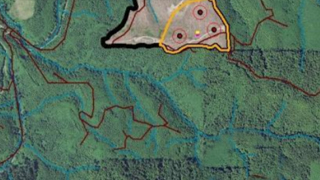
The Intensive Forest Management study examined the responses of multiple species groups, including birds, ungulates, moths and plants, to a variety of herbicide application treatments. Since 2011, we have worked with partners at Oregon State University, Oregon Department of Forestry and other private landowners and found that even with higher levels of vegetation control, reduction of biological diversity either did not occur or was minor and short-lived when it occurred.
In addition to our many ongoing research and conservation projects, in 1995 we developed a Northern Spotted Owl Habitat Conservation Plan with the U.S. Fish and Wildlife Service for our Coos Bay Tree Farm in Oregon. This 50-year commitment will continue until 2045. The plan provides habitat for the owl on our timberlands and is designed to complement owl recovery efforts on state and federal lands in the Coos Bay region. Similarly, we are implementing a Multi-Species Habitat Conservation Plan, also with U.S. Fish and Wildlife, on our forests in Washington's Central Cascades. This plan focuses on northern spotted owl habitat, as well as that of a host of other species, including grizzly bear, wolf and lynx.
By using this website, you agree to our Privacy Policy. California residents: See our CCPA Privacy Notice for details on what personal information we collect and for what purposes.




